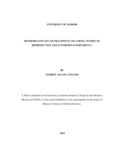| dc.description.abstract | Background
Contraceptive use is the expression of individual desire to space or to limit birth.By
practicing family planning, couples can improve the health of mothers and children
through birth spacing and avoiding high risk pregnancies. In addition to this, family
planning can help to slow down population growth thereby contributing to economic
benefits such as poverty reduction. North Eastern Province has the lowest prevalence of
contraceptive use in Kenya. The determinants of contraceptive use among women in this
province are increasingly attracting attention from researchers and policy makers.
However policies aimed at increasing uptake of contraceptives need to be based on a
sound assessment of the sources, reasons and determinants of contraceptive use since
policy decisions based on intuition are likely to be misguided.
Objectives
The study investigated the factors related to contraceptive use by women in North
Eastern Province of Kenya. The specific objectives were;
1. To determine the methods of contraceptives available to women and their use in
North Eastern Kenya
2. To determine the factors related to Contraceptive use by women of reproductive
age in North Eastern Kenya
Methods
Data from Kenya Demographic and Household Survey (KDHS, 2008/09) was used for
the analysis. The study design was a population based Cross Sectional Survey. Eligible
women were 15 years or older but less or equal to 49 years old and resident in the
province at the time of the survey. Sampling involved a two stage cluster design. Tables
were used to present the methods of contraceptives available, their use by women and
reasons for not using contraceptives. Logistic regression model was used to model the
association of various covariates on Contraceptive use taking into account potential
confounders. Results
A total of 608 women who were 15 years or older but less or equal to 49 years old were
included in the sample. Over 97.5% of the women were Muslims. The methods of
contraceptives available were Pill, Injections and Norplant. Over 97.7% of the sample of
women did not use any method of contraception. Only 1.48% used Injection method.
37.76% of the women indicated that the Muslim religion prohibits the use of
contraceptives. Univariate Logistic regression models found associations between the
covariates, residence, education, socioeconomic status, occupation religion and mass
media on contraceptive use. Specifically, urban residents were more likely to use
contraceptives compared with their rural counterparts. Women with primary, secondary
and higher education were more likely to use contraceptives and the magnitude of effect
increased with increasing level of education. Women who were exposed to media were
more likely to use contraceptives compared to those who were not. Muslims were less
likely to use contraceptives compared to Protestants. In the multivariate analysis only
religion and watching television remained statistically significant. Muslims were 98.98%
[Adjusted OR = 0.02, P < 0.003, 95% CI (0.002, 0.0267)] less likely to use
contraceptives compared to protestants. Women who were accessible to television were
about 10 times [Adjusted OR = 10.65, P = 0.031, 95% CI (1.23, 91.84)] more likely to
use contraceptives compared to those who did not.
Conclusion
Religion and Mass media were significantly associated with Contraceptive use among
women in North Eastern province of Kenya. Muslims were less likely to use
contraceptives compared to Protestants. Women who were exposed to television were
more likely to use contraceptives than those who were not. Involving Muslim leaders in
design, planning and implementation of family planning programs in this province is
critical for the success of family planning programs in the province. | en_US |

